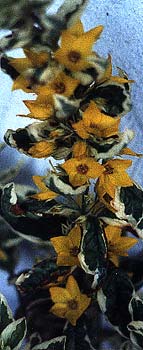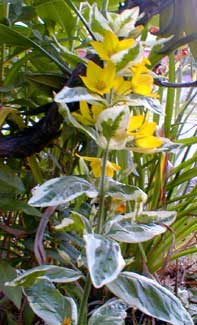
Variegated Yellow Loosestrife
& Alexander the Great
"A pair of little Boys at play,
Chasing a crimson butterfly;
The taller followed with his hat in hand,
Wreathed round with yellow flowers."
-William Wordsworth
(1770-1850)
(1770-1850)
Loosestrife ( Lysimachia punctata), native to Central Europe, gets its name from an old superstition that it loosens or negates the anger or strife of wild beasts. John Gerard in his classic but largely plagiarized study of herbs published in 1597 noted that loosestrife was attached to the yokes of oxen to soothe their tempers, "appeasing the strife & unrulinesse which falleth out among oxen at the plough."
 It's genus name Lysamachia alludes to this belief, for it is named for Lysimachus (361-281 B.C.E.), who was a general to Alexander the Great, & ruled a quarter of Alexander's divided Empire upon Alexander's death.
It's genus name Lysamachia alludes to this belief, for it is named for Lysimachus (361-281 B.C.E.), who was a general to Alexander the Great, & ruled a quarter of Alexander's divided Empire upon Alexander's death.Lysimachus was said to have calmed a monstrous leopard by waving an herbal branch before it. The waving branch was probably not loosestrife, but was in reality his war-standard. The monstrous leopard is a recasting of scripture's four-headed flying leopard in Daniel 7:5. The leopard had long been symbolic of Greece, & the four-headed leopard represented Alexander's four generals themselves.
One would suppose this loosestrife cultivar, which is called 'Alexander,' was named after the young conqueror whom Lysimachus followed. And perhaps someone did note the coincidental connection when naming it. But it was really named for a certain Mrs. Alexander of York, England, who introduced this garden variety to the world in 1990.
'Alexander' has variegated leaves, sage-green with cream borders, & sunny yellow flowers. It purports to be a more restrained version of a flower that in the species form is notoriously invasive & often too aggressive for neighboring perennials. Even 'Alexander,' though comparatively slow growing, eventually becomes a large two-foot by two-foot clump with a big root system that can threaten nearby delicate flowers, so take care what you plant around it.
I originally planted one small start of 'Alexander' in the worst possible location way back under the eaves of the house, during a period of experimenting with what might survive in seemingly unplantable locations. In that spot it was underwatered, had almost no sun, was more than once trampled flat by a racoon that had tramped a trail along that side of the house, & two years later it was still alive, if only pitifully so. The first photo above shows it right up against the drywall on a "good" day in July (2003).
Before its third year in that awful location I one day dug it up & went out to a roadside xeriscape sungarden & planted it inside the dripline of a large shrub where it'd have some protection from the harshest summer light. By the following July it had grown to thrice the size it had achieved in two years in its former awful location. It's shown in the second July photo (2005), still small & still in one of the less attended locations, but obviously on its way to becoming a mature clump.
It was fun, if a little cruel, to have discovered how really lousy the conditions could be & it would not give up on life.
The genus name is shared with diverse plants, most famously Creeping Jenny, likewise invasive & disliked by some gardeners who can't keep it from creeping through their lawns. The different species under this genus may look nothing similar, but are all in the primrose family.
Alexander's Loosestrife can get by in poor soil so long as it is never completely dry. If it experiences drought, the variegated leaves will quickly brown at the edges. We have planted it behind forest bowl that has been tricked out as a waterfall & bog garden. It blooms beginning June & lasts until first frost.